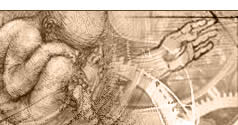 |
 |
 |
 |
 |
 |
 |
 |
|
 |
 |
 |
44 Radioactive decay to lead
|
| Menu | back |
Frequently, the quantity of uranium 238 and lead 206 are measured for radiometric determination of the age of rocks. The half-life with which uranium 238 decays to form lead 206 is 4.46 billion years. After 4.5 billion years (the alleged age of the Earth), at least the same quantity of lead and uranium should therefore be present on the Earths surface. However, in reality, there is more lead than uranium. It could be assumed that an undetermined quantity of lead 206 formed directly when the rocks originated. Moreover, in addition to uranium 238, 52 other elements also decay to form lead 206. The half-life of these elements varies between a few microseconds and 245,500 years. It is therefore not possible to estimate how much of the lead 206 present today actually originated from uranium 238.
Various methods are used for radiometric determination of the age of rocks. The principle is always the same. An unstable or radioactive initial material decays to form a different stable element. The subsequent list shows how many other unstable elements also decay to form the same stable element:
|
Potassium Argon
|
3
|
other elements also decay to
|
Argon
|
Rubidium Strontium
|
4 |
" " " " " |
Strontium
|
Samarium Neodym
|
13 |
" " " " " |
Neodym
|
Lutetium Hafnium
|
10 |
" " " " " |
Hafnium
|
Rhenium Osmium
|
9 |
" " " " " |
Osmium
|
Thorium 232 Lead 208
|
26 |
" " " " " |
Lead 208
|
Uranium 235 Lead 207
|
45 |
" " " " " |
Lead 207
|
Uranium 238 Lead 206
|
52 |
" " " " " |
Lead 206
| |
Generally, only the decay of uranium 238 is taken into consideration when using the uranium 238/lead 206 method (1). All other elements, which also decay to form lead 206, are ignored.
Decay sequence from uranium 238 to lead 206:
|
Uranium 238
|
decays with a half-life of
|
4.46 billion
|
years
|
to
|
Thorium 234
|
" " " " " " |
24.1
|
days
|
" |
Protactinium 234
|
" " " " " " |
46.69
|
hours
|
" |
Uranium 234
|
" " " " " " |
245,500
|
years
|
" |
Thorium 230
|
" " " " " " |
75,400
|
years
|
" |
Radium 226
|
" " " " " " |
1,599
|
years
|
" |
Radon 222
|
" " " " " " |
3.82
|
days
|
" |
Polonium 218
|
" " " " " " |
3.04
|
minutes
|
" |
Lead 214
|
" " " " " " |
27
|
minutes
|
" |
Bismuth 214
|
" " " " " " |
19.9
|
minutes
|
" |
Polonium 210
|
" " " " " " |
0.16
|
milliseconds
|
" |
Lead 206 (is stable)
|
|
|
|
| |
Using the model of a young Earth, the origin of the radiogenic lead present today could be traced back to several short-lived isotopes. In the model with a 4.5 billion-year-old Earth, the radiogenic lead can be traced back exclusively to the decay of long-lived isotopes. Both interpretations are speculative.
The decay time of short-lived isotopes is shown on the following internet site: http://nucleardata.nuclear.lu.se/nucleardata/toi/sumframe.htm. (Specify atom mass and click on show drawing.)
These 45 | Menu |
back
|
References:
|
| (1) |
Charles W. Lucas Jr., Radiohalos Key Evidence for Origin/Age of the Earth, Proceedings of the Cosmology Conference 2003, Ohio State University, Columbus, Ohio. | |
| |
Comment this Site!
Pavel Kabrt wrote:
Dear brothers,
evolutionists around me are asking (These 44), which other elements (exept those ten showed in the table) are decaing to Pb-206. One evolutionst told me, that he found 18 elements (including those stated in your table), which are known an
|
 |
 |
 |
 |
|

